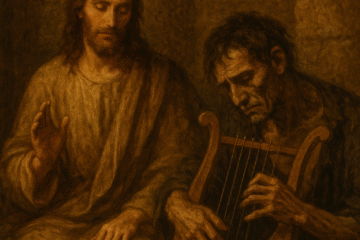Lesallan | April 1, 2025
Reflections on Isaiah 66:1–2 (KJV): Embracing the Divine Presence
Isaiah 66:1–2 (King James Version)
Introduction
The passage from Isaiah 66:1–2 (KJV) offers a profound call to reexamine what it means to offer genuine reverence spiritually and practically. By declaring that “the heaven is my throne, and the earth is my footstool,” God reminds us that the divine transcends man-made structures and ceremonies. In asking, “where is the house that ye build unto me? and where is the place of my rest?” the scripture challenges believers to search within their own depths for authentic connection rather than relying on outward symbols of faith (Isaiah 66:1–2, King James Version).

The Majesty of the Divine
This vivid imagery underscores the expansive nature of God’s sovereignty. The heavens and the earth are not simply parts of creation but serve as the ultimate expressions of divine authority and intimacy—where creation itself becomes a testament to the Creator’s greatness. In our modern context, such imagery is a poignant reminder that while human ingenuity can craft beautiful sanctuaries, the true “house” where God dwells is found in our hearts and in the community of believers who live lives of sincere devotion.
Humility and True Worship
Central to this passage is the emphasis on humility and contrition. The text distinguishes between elaborate edifices and the humble spirit by stating that God “will look to him that is poor and of a contrite spirit, and trembleth at [His] word” (Isaiah 66:2, King James Version). Here, the scripture compels us to reconsider societal values that often equate piety with external rituals or material display. Instead, authentic worship arises from an inner posture of humility—a recognition that genuine faith is measured by the openness of one’s spirit, not the perfection of physical surroundings.
Contemporary Implications
In today’s world, where distractions abound, and the allure of superficial success is omnipresent, Isaiah 66:1–2 offers an invitation to live with intentional simplicity. The passage beckons us to cultivate an inner life that mirrors the divine order and beauty inherent in all of creation. Whether interpreted through the lens of traditional religious practice or modern spirituality, the message is consistent: true reverence is not constructed but experienced. This timeless encouragement inspires a reorientation toward values that prize introspection and heartfelt commitment over ostentation.
Conclusion
Isaiah 66:1–2 (KJV) stands as a transformative reminder that the divine presence envelops every aspect of existence. It prompts us to ask difficult questions about where we locate our sacred space and whether our traditions truly foster a deep, personal relationship with the Creator. In a culture increasingly driven by material shows and artificial constructs, the call to adopt a contrite and humble spirit remains as relevant as ever. As we strive to forge a living testimony of faith, may we remember that the ultimate invitation is to reside in the sacred, unbuilt space of our own hearts.
This reflective exploration invites readers to ponder not only the scripture’s historical context but also its practical implications for modern spiritual life. It suggests that the true measure of faith is found in the depth of one’s inner experience and willingness to live simply and sincerely. Such a perspective can enrich one’s journey toward an authentic connection with the divine, encouraging an ongoing dialogue between ancient wisdom and contemporary life.
In Christ,
Lesallan – April 1, 2025


